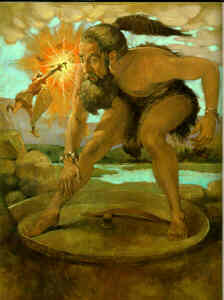The Monks and the Giants
 Since The Monks and the Giants is such an obscure text in today's literary circles,
it is important to note a few specifics about that work. Originally proposed for
publication in 1816 after the advice of several of Frere's friends, this work did not actually
see publication until 1817 when the first part was published by Murray; the second and
final part of the work was published in 1818. Originally having been slated for a much
more protracted treatment, Frere cut the work short after the second part, refusing to do
any more with it because of the work's general reception.
The Monks and the Giants is actually a somewhat later title for this work.
Originally, Frere published the work in a pseudo-anonymous fashion, attributing it to
one William Whistlecraft (deceased) who supposedly composed it in 1813, and claiming that
the author of the preface was Robert Whistlecraft, Will's surviving brother. These two brothers were
supposedly harness and collar makers who resided in Suffolk. This unusual publication
scheme led to the works' having multiple titles; while being later titled The Monks and
the Giants, the original work was headed as Prospectus and Specimen of an Intended
National Work, and later scholars would sometimes refer to it by the fictitious author,
dubbing it Whistlecraft. In this analysis of the work, all three of these titles
are used interchangeably.
Since The Monks and the Giants is such an obscure text in today's literary circles,
it is important to note a few specifics about that work. Originally proposed for
publication in 1816 after the advice of several of Frere's friends, this work did not actually
see publication until 1817 when the first part was published by Murray; the second and
final part of the work was published in 1818. Originally having been slated for a much
more protracted treatment, Frere cut the work short after the second part, refusing to do
any more with it because of the work's general reception.
The Monks and the Giants is actually a somewhat later title for this work.
Originally, Frere published the work in a pseudo-anonymous fashion, attributing it to
one William Whistlecraft (deceased) who supposedly composed it in 1813, and claiming that
the author of the preface was Robert Whistlecraft, Will's surviving brother. These two brothers were
supposedly harness and collar makers who resided in Suffolk. This unusual publication
scheme led to the works' having multiple titles; while being later titled The Monks and
the Giants, the original work was headed as Prospectus and Specimen of an Intended
National Work, and later scholars would sometimes refer to it by the fictitious author,
dubbing it Whistlecraft. In this analysis of the work, all three of these titles
are used interchangeably.